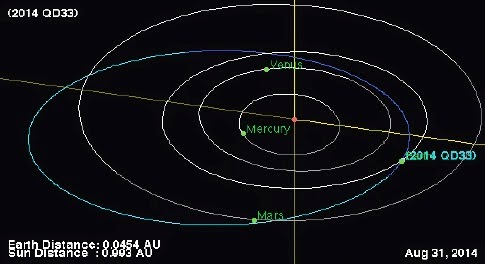Asteroid (163132) 2002 CU11 passed by the Earth at a distance of about 5 188 000 km (13.50 times the average distance between the Earth and the Moon, or 3.5% of the average distance between the Sun and the Earth), slightly before 3.15 am GMT on Saturday 30 August 2014. There was no danger of the asteroid hitting us, though were it to do so it would have presented a serious threat. (163132) 2002 CU11 has an estimated equivalent diameter of 410-1300 m (i.e. it is estimated that a spherical object with the same volume would be 410-1300 m in diameter), and an object of this size would be predicted to be capable of passing through the Earth's atmosphere relatively intact, impacting the ground with an energy equivalent to about 3100-60 000 megatons of TNT (roughly 182 000-3 500 000 times the energy of the Hiroshima bomb). Such an event would result in a crater between 6 and 15 km across, cause devastation on a global scale and would have the potential to affect the climate globally for decades after the impact event.
Image of (163132) 2002 CU11 taken from Balen in Belgium on 13 August 2014. Alfons Diepvens.
(163132) 2002 CU11 was discovered on 7 February 2002 by the Massachusetts Institute of Technology's Lincoln Near Earth Asteroid Research Laboratory in Socorro, New Mexico. The designation 2002 CU11 implies that it was the 295th asteroid (asteroid U11) discovered in the first half of February 2002 (period 2002 C), while the longer designation 163132 implies that it was the 163 132nd asteroid ever discovered (asteroids are not given this longer designation immediately, to avoid false and duplicate sightings being awarded names).
The calculated orbit of (163132) 2002 CU11. JPL Small Body Database Browser.
(163132) 2002 CU11 has a 492 day year orbital period and an eccentric orbit tilted at an angle of 49° to the plane of the Solar System, which takes it from 0.86 AU from the Sun (i.e. 86% of the average distance at which the Earth orbits the Sun) to 1.58 AU from the Sun (i.e. 158% of the average distance at which the Earth orbits the Sun, slightly more than the distance at which the planet Mars orbits the Sun). It is therefore classed as an Apollo Group Asteroid (an asteroid that is on average further from the Sun than the Earth, but which does get closer). This means that close encounters between the asteroid and Earth are fairly common, most recent having occurred in March this year and the next predicted in September 2018. As an asteroid on a trajectory which brings it extremely close to Earth which is large enough to cause serious harm should it collide with Earth it is also classified as a Potentially Hazardous Asteroid.
See also...
Asteroid 2014 QD364 passed by the Earth at a distance of 2 332 000 km (6.07 times the average distance between the Earth and the Moon, or 1.6% of the...
Asteroid 2014 QD33 passed by the Earth at a distance of 5 515 000 km (14.35 times the average distance between the Earth and the Moon, or 3.7% of the...
The Alpha Aurigid Meteor shower occurs each year between 25 August and 6 September, peaking between 11.30 pm GMT on 31 August and 0.30 am GMT on 1 September. However the shower is notoriously hard to observe, having been recorded only in the years 1911, 1929, 1930, 1935, 1979, 1980, 1986, 1994 and 2007...
Follow Sciency Thoughts on Facebook.





